Ankeny Parents Agains Standards Based Grading
Standards-based grading (SBG) is an innovation in instruction that focuses on learning and helps increase achievement. It is ofttimes combined with updated instructional practices and culture to improve appoint students and foster a positive environs. This page is an introduction for parents and educators new to standards-based education.
The Basics of SBG
Traditionally teachers focus on teaching, the attempt to evangelize knowledge. In SBG they also measure out educatee learning, to understand the effectiveness of instruction. Instead of a single overall grade, SBG breaks down the subject thing into smaller "learning targets." Each target is a teachable concept that students should master by the stop of the course. Throughout the term, student learning on each target is recorded. Teachers track student progress, give appropriate feedback, and conform instruction to run into student needs. Figure 1 shows instance written report cards that highlight the differences between traditional and SBG.
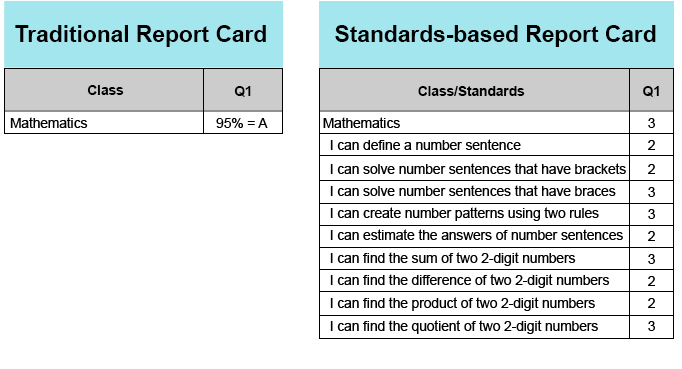
Figure 1: Examples of Traditional and Standards-based Grading
Traditional grading and SBG also utilize different grading scales. In traditional grading, students are primarily measured by the pct of work successfully completed. The assumption is that higher completion rates reflect greater mastery, and earn higher grades. Oftentimes 90% achieves an A, 80% a B, etc.
In SBG, grading is based on demonstration of mastery. Students attempt standards-aligned activities (projects, worksheets, quizzes, essays, presentations, etc.). Teachers assess the student output and cull the appropriate mastery level that was demonstrated.
Typical scales are 1-4 and reverberate students' increasing skill. 1'southward indicate that students accept little understanding of a concept, and consequently cannot demonstrate any mastery. When starting a new target, many students accept no prior knowledge, and begin at 1. Equally students larn, they tin can demonstrate partial mastery, and score 2. Once they meet a target, they score 3. Typically 4's are used for students who exceed targets. Effigy 2 shows example traditional and SBG grading scales.
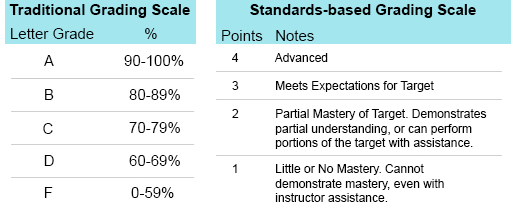
Effigy 2: Traditional and Standards-based Grading Scales
Note: Even though ane-4 is popular, SBG grading scales vary widely. Scales can exist 1-5, 0-four, utilize half points, and utilise messages instead of numbers. Yours may exist different.
In standards-based educational activity, teaching is responsive to learning. When starting a new target, teachers present introductory lessons. As students progress, they are offered more than complex material. They continue working and learning until they reach the target. Retrieve of SBG as a ladder, where students climb up, "a rung at a time," eventually reaching the top.
Afterwards receiving instruction, some students progress immediately, simply most do non. It's common for students to be confused, and simply partially complete an activity. Teachers regularly provide feedback, reteach, and offering additional opportunities to reach "the next rung." This procedure requires patience and exercise, and is repeated until students reach the target.
SBG is powerful because information technology provides a framework to regularly measure student progress. When teachers take continuous understanding of students' mastery, they can adapt teaching to meliorate see students' needs. This causes education to be more than effective and engaging.
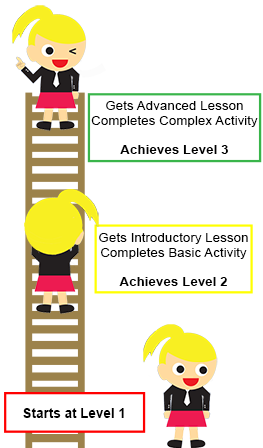
Figure 3: Climbing to mastery
How Does SBG Ameliorate Education
At present that nosotros've described the mechanics of SBG, let'south look at the advantages standards-based pedagogy brings to the classroom. Many instructional changes improve student date and learning.
Improved Feedback
In SBG environments, better feedback accelerates learning. Instead of simply giving scores like 9/ten or 85%, teachers give feedback about the job performed and skills used. This helps students understand their current areas of comeback, and helps them reach the side by side level. This positive environment speeds learning and students reach higher levels of achievement -- all while being deeply engaged and enjoying schoolhouse.

Figure 5: Teachers Give Feedback
Pupil Ownership of Education
Learning targets are typically written in educatee-friendly language, so they can understand the goals of instruction. Targets may be further broken down by rubrics to map out the steps required to reach the "top of the ladder." This allows students to understand the path to success, and enables them to better appoint in their learning. When working on an activity, they tin self-assess and reflect on their own performance. They tin can place areas of improvement and self-direct their activities. This leads to greater ownership of their learning. A typical rubric is shown in Figure 6.
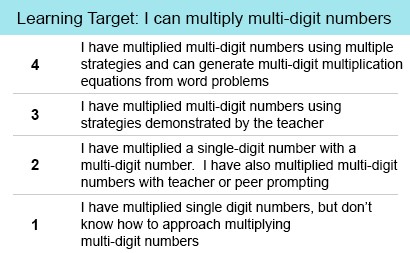
Figure 6: Rubric breaks downward a learning target
More than Relevant Instruction
In traditional classrooms, many teachers mechanically present curriculum to students -- lesson 1 on day i, lesson 2 on day two, etc. While there are exceptions (eastward.g. - early elementary reading), ofttimes at that place is little adjustment to instruction due to learning. Because students learn at different rates, some are bored because the pace is as well slow. Others are confused because education is too fast. This is a daily claiming in traditional classrooms.
In SBG classrooms, teachers better understand student mastery. At any time, they know which students are at level 1, ii, or 3. This helps teachers offer level-appropriate work. Students at level ane get activities that help them attain level 2. Level 2 students go activities to climb to level 3. Classrooms often suspension into smaller groups with students working independently on level-appropriate activities. This is called "differentiated instruction," or DI for short.
In this environment, students are less frustrated by poorly-fitting educational activity. School is a more positive experience when form cloth is relevant and interesting. By improving the use of instructional time, students learn more than and brand increased bookish progress.
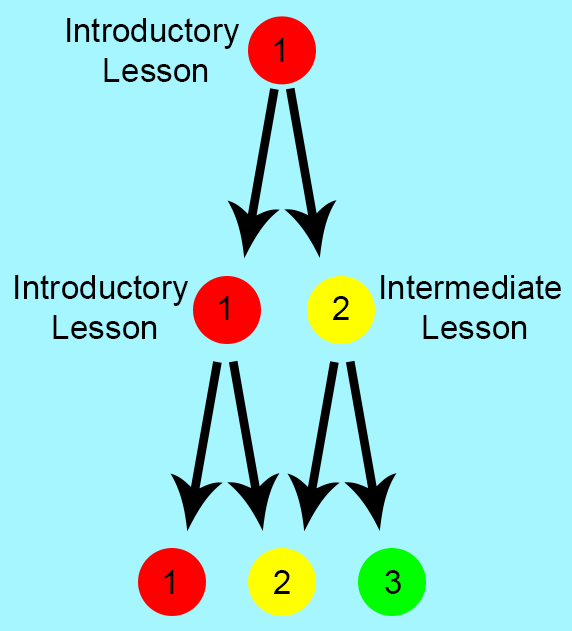
Figure 4: Adapting Instruction to Student Learning
Learning Provides Intrinsic Motivation
Some students may be extrinsically motivated by metrics, and strive to improve in measured areas. In traditional classrooms, this often encourages students to "chase points." Many volition perform tasks that award points and enhance their averages (due east.g. - extra credit).
Conversely, it'south common to hear students ask, "Will this be graded?" They often will skip any activity not entered into the gradebook, regardless of merit. This creates unhealthy incentives which skew student behavior and attitudes.
In SBG, the focus is on learning and mastery. Striving for mastery is an intrinsic motivator and transforms student attitudes. They learn for their own enjoyment and sustain loftier levels of endeavour and achievement.
Emotional Rubber and Fearfulness of Testing
At the start of each marking catamenia, students start with 100%. Their averages fall as they brand mistakes. Students with the fewest mistakes earn the highest grades. Depending on the size of the error (due east.g. - a nix), it may exist incommunicable to recover and earn a "good grade." This high-stakes surroundings can create test-taking fear and cause anxiety, which interferes with learning.
In SBG, scores get upward as students larn. Final grades are reflective of mastery at the end of the course, then there's footling penalisation for early mistakes. No issue can "ruin" their grade. This creates an emotionally prophylactic environment where students are encouraged to stretch themselves, make mistakes, and acquire.
While SBG removes the problem of zeros, information technology'southward also common for organizations to allow redo's. When a student gets a poor score, they tin ofttimes work more on the topic, increasing their learning, and reassess. The ability to reach mastery is historic versus the focus on the number of mistakes fabricated along the fashion.

Figure 6: Students tin Fear Testing
Accurate Measurement of Learning
I pitfall of traditional grading is inaccuracy. Educatee averages are highly dependent on the difficulty of work assigned. If teachers present only low complexity activities, students can earn loftier scores with only a weak control of the textile.
The opposite is also truthful. Highly demanding instructors may nowadays very difficult work, resulting in overly depression educatee scores. Curving and extra credit are used to adjust averages into more appropriate distributions.
In both cases SBG tin amend the state of affairs by providing clearer criteria for measuring mastery. Mastery of low complexity work yields lower grades while mastery of higher complexity work provides higher grades. Connecting grades to complication rather than percentage completion yields more accurate and consistent grades.
How TeacherEase Helps SBG
This certificate was written by the team that produces TeacherEase, software for standards-based learning. We believe that successful SBG requires good technology, so nosotros congenital TeacherEase to run into this demand. It includes all the tools necessary: commission collaboration, learning targets, rubrics, assessments, instructional content management, information analytics, gradebook, study cards, and parent portal. For more information, bank check out: TeacherEase: Software for Standards-based Learning.
Additional SBG Videos
For more data, we recommend the SBG-related videos below.
Source: https://www.teacherease.com/standards-based-grading.aspx
Belum ada Komentar untuk "Ankeny Parents Agains Standards Based Grading"
Posting Komentar